Our editor-in-chief Nate Yapp is proud to have contributed to the new book Hidden Horror: A Celebration of 101 Underrated and Overlooked Fright Flicks, edited by Aaron Christensen. Another contributors include Anthony Timpone, B.J. Colangelo, Dave Alexander, Classic-Horror.com's own Robert C. Ring and John W. Bowen. Pick up a copy today from Amazon.com!
Shiverin' 6: Great Episodes of Horror Television
Doing a list-style feature can be an easy way to generate content. I like the idea in principle, but I try to avoid presumptuous "best of" lists when I can (and sometimes, I'll admit, I can't).
With this in mind, I've concocted the "Shiverin' 6" (with apologies to the Cinematical Seven). This irregular feature will present a list of a half-dozen really excellent films (or television episodes or fictional characters or whatever) that represent a certain topic, category, or subgenre. These items will not be touted as "the six best", but as "six of the best." Readers can (and should) leave a comment telling us about their favorites -- agreeing or disagreeing with our choices and making their own additions.
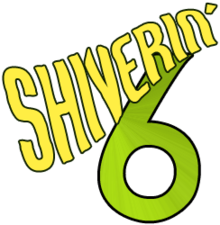
The inaugural Shiverin' 6 deals with individual episodes of television programs, in honor of the launch of NBC's new horror anthology series Fear Itself. The selection criteria for this list was simple -- no program could have more than a single episode on the list, to keep the results varied. The final list was largely compiled by me, with certain selections being made by Timothy J. Rush and Julia Merriam, who do the write-ups for their own picks. We could not have put this together without the suggestions of the Classic-Horror staff and several of my television-savvy friends. I hope they enjoy the results, as I hope you do.
"Pigeons from Hell" from Thriller (1960 - 1962)
Original Airdate: June 6, 1961
Director: John Newland
Teleplay: John Kneubuhl, based on Robert E. Howard's short storyTwo years before Alfred Hitchcock threatened cinema audiences with an avian onslaught, a different Master of Horror introduced a tale of fearsome fowl to a much smaller screen. A contemporary to Alfred Hitchcock Presents and The Twilight Zone, the Boris Karloff-hosted Thriller was steeped in Gothic atmosphere (Stephen King once called it the best horror television program ever). "Pigeons from Hell" is considered by many to be the program's finest hour.
Adapted by John Kneubuhl (The Screaming Skull) from the Robert E. Howard ("Conan the Barbarian") short story, "Pigeons" tells the tale of a spooky old mansion in the American South, covered in the ominously cooing birds of the title. Two brothers venture into the house, but after one is killed, the survivor teams with the local sheriff to discover the secrets of the house and put a stop to its murderous curse.
Director John Newland maintains a disquieting atmosphere throughout the episode. Not content with a few streaks of darkness, Newland covers the mansion with noir shadows; the house fairly aches with them. He also manages to create several excellent scenes of horror, the best of which is when the dead brother, his skull smashed and his face covered in blood, stalks his sibling with a hatchet. The shadows slide on and off the ambulatory corpse as he slowly advances on his terrified victim. As Karloff might say, "It's a Thriller."
"Nightmare at 20,000 Feet" from The Twilight Zone (1959 - 1964)
Original Airdate: October 11, 1963
Director: Richard Donner
Teleplay: Richard MathesonWrite-up by Timothy J. Rush
A script by the man who penned the stories for The Last Man on Earth and Duel, William Shatner before he became a self-parody, and the director of The Omen. There's a lot of talent poured into the Twilight Zone episode "Nightmare at 20,000 Feet," and it shows. It takes a simple concept -- a man recently recovered from a nervous breakdown spotting a "gremlin" on the wing of a plane -- and plays it to the inherent strengths.
"Nightmare" combines a lot of very basic fears: the fear of flying, of the unknown, of the mentally unstable. William Shatner does an amazing job at playing the part of a man who is seemingly losing his mind. You manage to sympathize both with his plight, since no one believes his ravings of the gremlin on the wing, and with those of his wife and the co-pilot who simply believe he is being mad and disruptive.
Then there is the gremlin itself. It's played not as some malicious monster, but as simply a creature who has stumbled upon the plane by chance. It wanders the wing in curiosity, investigating the propellor and the motor not out of a want of destruction but a genuine search for knowledge. It's that sense of realistic motives that really puts the fright into the episode.
So really, it's a case of everything coming together, and Donner does a great job of tying it all together with great direction, choosing the right times to show us the view out to the wing while still keeping the claustrophobic feel of the action being all trapped inside this one plane.
In other words? This is Twilight Zone at its best. Pure television magic.
"The Form of Things Unknown" from The Outer Limits (1963 - 1965)
Original Airdate: May 4, 1964
Director: Gerd Oswald
Teleplay: Joseph StefanoThe original run of The Outer Limits had a lot of effective hours and just as many effective monsters, but one of its strangest, most discordant episodes had no real monsters at all. "The Form of Things Unknown" is a bizarre blend of genres; it starts off as a pastische on Diabolique, adds in an old dark house thriller and a healthy helping of science fiction, then shakes the whole concoction generously. Call it a Creepy Cosmo.
The deviation of "Form" from the normal Outer Limits template wasn't an accident. The episode was originally produced by show-runner Joseph Stefano (Psycho) as the pilot for a different series, one that apparently did not pan out. No matter. As a part of the Outer Limits legacy, its power to unnerve is not dimmed by a lack of latex-shrouded monsters.
I'll admit that this one is a strange choice. The writing itself only occasionally veers into the territory of horror (and to find out where, you'll have to watch the episode -- to describe the plot would be useless). It's the camerawork where the real excitement lives. Director Gerd Oswald and cinematographer Conrad L. Hall (later to win three Oscars for his film work) make the visuals of the episode mirror the fragmented and often ambiguous nature of Stefano's script. You won't see this many shots this inventive and dare I say ballsy in television programs of this era (or, really, any other). You'd be hard-pressed to find many movies that look like this. There's a glorious symmetry in an early scene where two murderesses-to-be (Vera Miles and Barbara Rush), one clad in white, the other in black, approach the edge of a lake in tandem. Later, a tight two-shot of Cedric Hardwicke and David McCallum puts Hardwicke as the natural visual focus, as if daring us to tear our eyes from McCallum's uncanny command performance -- knowing full well that we can't. Even if the ending is a little bit of a disappointment given the dense thicket of oddity that precedes it, this is one of the most unusual episodes of television in the history of the medium.
"Detour" from The X-Files (1993 - 2002)
Original Airdate: November 23, 1997
Director: Brett Dowler
Teleplay: Frank SpotnitzWrite-up by Julia Merriam
Everyone remembers The X-Files, the 90s cult sensation that survived, and thrived, in the Friday night slot that should have spelled disaster. While much of the series focused on an overreaching story arc that put our stalwart heroes, FBI Special Agents Fox Mulder and Dana Scully, at the center of an alien conspiracy, the show was probably best loved for its great one-off episodes. Both creepy and quirky, these stand-alone episodes showcased some of the best that The X-Files had to offer, pulling material both from myth and imagination. "Detour," which aired early in the fifth season, is one of the best of those episodes.
Scully and Mulder find themselves in the backwoods of Florida. It doesn't really matter how, but needless to say, there's some weird stuff going on. People are disappearing in the woods, houses are being broken into and pre-pubescent boys are being menaced by invisible monsters. And, come hell or high water, Mulder is going to find out why. As their search leads them deeper into the forest, our agents discover that there are some secrets better left in peace.
"Detour" stands out as a fantastic example of X-Files' direction. Unlike other episodes, where the threat was something visible and easily tracked, Detour's menace blends into its environment almost perfectly, often betrayed only by a pair of glowing eyes. The camera pans, following the menacing rustle of leaves and then stops, forcing us to lose track of the creatures as surely as the characters have. As the camera searches, so do we until not only do we scour the screen for evidence of habitation, but we scour the corners of our own living, both hoping for and dreading the appearance of those malevolent red eyes.
"Hush" from Buffy the Vampire Slayer (1997 - 2003)
Original Airdate: December 14, 1999
Written & Directed by Joss WhedonFor all of its vampires, demons, and other supernatural beings, Buffy the Vampire Slayer was only occasionally scary. The series followed Buffy Summers (Sarah Michelle Gellar), a girl based in the fictional town of Sunnydale who is gifted/cursed with superhuman abilities, mystically chosen to fight the things that go bump in the night. Generally speaking, once those bumpy things had their butts handed to them, they lost a lot of their scare power... but not always.
Written and directed by series creator Joss Whedon, "Hush" sprang from an attempt to dispel the notion that the show's primary draw was its clever dialogue. Roughly 13 minutes in, a spell is cast over Sunnydale that robs the inhabitants of their ability to speak. Whedon uses this experiment in form to explore the idea that "when you stop talking, you start communicating." Each of the actors had to relay their performances in mime, often to great comic effect (one hilarious moment in the episode involves a visual double entendre). However, "Hush" contains more than mere antics. It is also the home of the politely vicious Gentlemen.
Looking very much like the children of Graf Orlok if they had all gone into the undertaking business, the Gentleman glide into Sunnydale on nothing but air and Christophe Beck's Elfman-esque score. Their purpose is not clear -- although we know they need to collect seven human hearts, we're never told why. The reason is not the point; the way they go about doing their work is. If it was only that they smile perpetually or that they never utter a sound, they would be creepy enough. But no, on top of those traits, they are well-mannered. Upon returning to their clock tower headquarters with their first human heart, four of the Gentleman softly golf clap for their leader (Doug Jones), who puts up his hands in a grotesque "Oh please, it was nothing" gesture. Words don't do justice to this ballet of courteous monstrosity.
Then again, that's kind of the point, isn't it?
"Blink" from Doctor Who (2005 - present)
Original Airdate: June 9, 2007
Director: Hettie Macdonald
Teleplay: Steven MoffatSurely there's nothing scary about a family-oriented British series about a 900-and-change-year-old time-traveling alien from Gallifrey? Ha. Russell T. Davies's modern revival of the classic sci-fi show has had its juvenile moments (like when farting aliens took over Downing Street) but when it's good, it's often frightfully good. So much so, in fact, that the BBC's official Doctor Who website posts a "Fear Factor" for each new episode, gauging a quartet of schoolchildren on how likely they are to hide behind the couch.
Nobody understands how to mix screams into the era-hopping adventures of The Doctor (David Tennant) and his various companions better than writer Steven Moffat. From lost children to the ticking of clocks to the dark itself, he has a knack for turning commonplace things into living (or unliving) entities of terror. In "Blink", he outdoes himself, crafting a heart-pounding shocker in the tradition of classic horror films. In it, a young woman is pitted against monsters that look like innocuous stone statues... the kind you can find pretty much anywhere and everywhere.
Called the Weeping Angels, the villains of the piece are cosmic assassins with an impenetrable method of defense -- they turn to stone statues when observed. When their victim looks away, however, they are lightning quick and it takes but a touch for them to do their work. Armed only with recorded warnings from a time-stranded Doctor, photographer Sally Sparrow (Carey Mulligan) has to somehow get to the Doctor's TARDIS (a time machine shaped like a police phone box from the 1950s) without getting caught. But how will she be able to manage it without succumbing to one of the most basic of human reflexes? The answer is only revealed after an exhilirating climactic struggle, made more shocking when the Angels reveal their horrifying true faces.
"Don't blink. Blink and you're dead. Don't turn your back. Don't look away. And don't blink. Good luck."




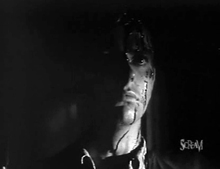

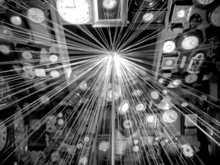
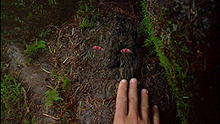
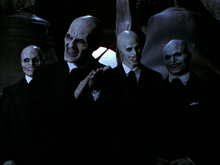
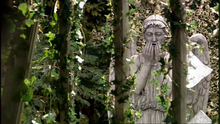



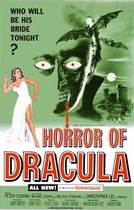

Most terrifying "X-Files" episode: "Home"
Tin Ear Tom:It's funny you
Tin Ear Tom:
It's funny you should mention "Home." While I was researching this article, I asked friends to recommend X-Files episodes, since it'd been years since I'd seen the program. "Home" thoroughly dominated the responses. I hadn't caught it when it originally aired, so I gave the DVD a spin. While it didn't really scare me -- I spent too much time relishing the strong ironic vibe that ran throughout -- I did see why everybody else was disturbed.
Nate Yapp
Editor-in-Creep
Classic-Horror.com
"He went for a little walk! You should have seen his face!"
Love the Shiverin' 6!
Hey - Love this new column! Can't wait to see the next one.
a little btvs addition - listening to fear...
chosen2forever -Yeah, I
chosen2forever -
Yeah, I definitely get that about "Buffy" -- I've been a fan ever since I saw the musical episode and I own all the seasons on DVD. I can safely say that show changed my life in a lot of ways. The horror angle was what interested me in the show initially, but what kept me were the well-drawn characters and the questions that Whedon and company were always putting forth about life, the universe, and everything. Plus, the wacky humor and kung fu is a lot of fun.
Nate Yapp
Editor-in-Creep
Classic-Horror.com
"He went for a little walk! You should have seen his face!"
angels
Shiverin' 6: Television
Well Done
Nice experience.The Raven as Homer plays the part of the main character, and Marge is featured as the lost Lenore. In the narration the main character, Homer, is asleep in front of a fireplace, when he hears a rapping at his chamber door. As he goes to open the door, a quick cut back to the treehouse, reveals a bored Bart and a trembling Homer who is still outside listening. Back in the narration, Homer opens the door to reveal that no one is there. Homer then goes to open a window and a raven with an uncanny resemblance to Bart flies in and frightens him.
STAR TREK,CATS PAW and WOLF
STAR TREK,CATS PAW and WOLF IN THE FOLD both written by ROBERT BLOTCH are pretty scary and the TNG episode NIGHT TERRORS was also pretty scary as well plus LOST IN SPACE,GHOST IN SPACE gets scary as well
I concur with the first
I concur with the first poster, The "Home" episode of The X-Files is horror at it's best. While the X-Files was always riveting, interesting or suspenseful, "Home" is the only episode that was genuinely shocking and scary. It should have been a movie.